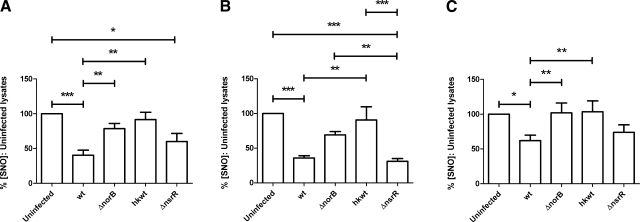Figure 4.
Effect of NorB on endogenously produced SNO in J774.2 cells. A, B) At t = 0 h, J774.2 cells were activated with 1 μg/ml LPS and 1000 U/ml rmIFNγ for 18 h. Cells then remained untreated (A) or were treated with 5 μg/ml cytochalasin D for 30 min at 37°C (B). Duplicate wells of J774.2 cells were then incubated for 4 h with suspensions of log-phase N. meningitidis in fresh medium (A) or medium containing 2 μg/ml cytochalasin D (B) plus wild-type strain MC58 (wt), mutant lacking NorB (ΔnorB), heat-killed wild type strain MC58 (hkwt), and mutant lacking NsrR repressor protein (ΔnsrR). Uninfected samples were incubated with fresh medium or medium plus cytochalasin D only. Lysates were produced using SNO-compatible lysis buffer plus 2% saponin. SNO content was determined by duplicate injection into I3− reaction mixture linked to ozone-based chemiluminescence and normalized to the protein concentration of each lysate. C) Cells were treated as in B, but lysates were produced in SNO-compatible lysis buffer using 3 freeze-thaw cycles. SNO measurements were determined by injection into phosphate-buffered saline (pH 7.0) containing a saturating concentration of Cu(I) and 1 mM l-cysteine, linked to ozone-based chemiluminescence. Data are percentages of SNO concentration in uninfected lysates. Bars denote means + se; n > 6. *P < 0.05, **P < 0.01, ***P < 0.001; ANOVA with Tukey’s multiple comparisons test.

